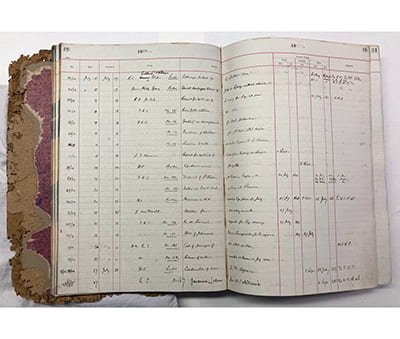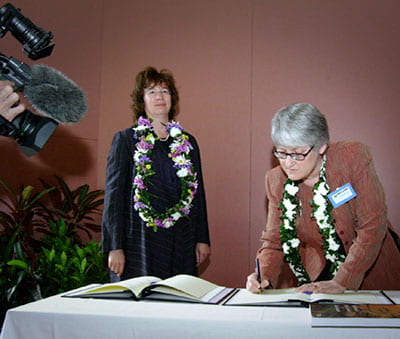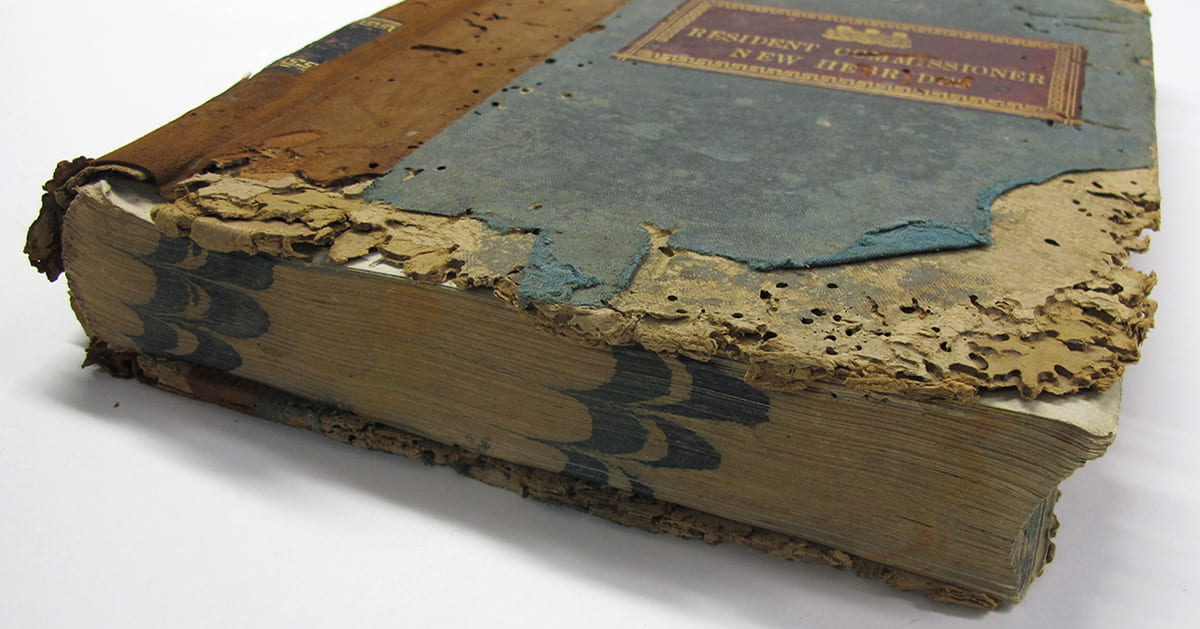To mark this year’s 20th anniversary of Special Collections, the curators have selected some intriguing items for the Twenty at 20 series. Here is number 16.
Most chewed archival item
Whether this is, in fact, the most chewed item held by Special Collections is debatable, but this correspondence register from the Western Pacific Archives (WPA) is a spectacular example of what insects can do to archival material and is one of my favourites.1
I suspect the damage to the cover of this register was caused by the larvae of the tiny, desiccated, beetle which fell out when I was photographing it for this story. The fibrous cardboard, fabric and glue used to make the cover provides a particularly tasty treat for insects, especially in the tropics where the register was used and kept before it came to Special Collections 20 years ago.
Made in Sydney, used in Port Vila, stored in Suva
The register was manufactured by Turner and Henderson – Account Book Makers in Sydney. It was used between October 1921 and October 1925 by staff of the New Hebrides British Service (NHBS) in Port Vila, Vanuatu, to record the details of letters received by the office and where they were filed. Before computers, files, correspondence registers, and related subject indexes, were essential tools for finding information and following up on related enquiries.
In the 1940s, the register and related series of annual correspondence files were superseded by a new filing system organised by subject. No longer required for everyday business, they were archived and eventually transferred to the Central Archives of Fiji and the Western Pacific in Suva. Here they joined other non-current records created by the British colonial administration of the Western Pacific, including the Western Pacific High Commission (WPHC), British Consul to Tonga (BCT) and British Solomon Islands Protectorate (BSIP).

Columns of careful recordkeeping inside the register record when letters were received and where they were filed.
When Fiji became independent in 1970, the archives relating to Fiji were transferred to the new Government and the remaining part of the archive renamed the Western Pacific Archive (WPA). During the 1970s, many British territories in the Pacific also gained independence and in 1978 the WPA was closed. The archive was split up, the BSIP material was transferred to the National Archives of the Solomon Islands (NASI) and those relating to the Gilbert and Ellice Islands were split between Kiribati and Tuvalu. The remaining WPHC, NHBS and BCT records were packed up and shipped to the United Kingdom (UK).2
A sojourn in Milton Keynes
In the UK, the WPA records were stored by the Foreign and Commonwealth Office (FCO) at Hanslope Park near Milton Keynes, Buckinghamshire. Although the FCO felt that the collection would be better in the Pacific where there would be the most interest in their contents, finding a suitable home was difficult. As the bulk of the WPA are British Public Records there were also concerns about housing the collection outside British Government jurisdiction.3
Returned to the Pacific region
The University of Auckland first offered the remaining WPA material a home in 1999, but it took three years to resolve the issues surrounding the transfer of the collection to the University. The hard work paid off, however, and in early 2002 the 600-plus linear metres of records were carefully packed up again and shipped back around the world. A formal handover was held at Waipapa Marae on 9 October 2002, and the collection was first made available to researchers in early 2003.4

Deputy Vice Chancellor (Academic) Professor Raewyn Dalziel signing the transfer documents with Heather Yamasee from the FCO, 2002. Photograph: Godfrey Boehnke.
Twenty years later, the WPA is one of the most used archival resources in Special Collections, attracting a wide range of visiting researchers and enquiries from academics, students, and inhabitants of the former British territories. The collection includes files on a remarkable range of subjects, including beetles – but the kind whose larvae eat coconut palms not books.
Katherine Pawley, Special Collections
Discover more
- Search the Western Pacific Archives
- Read more about the WPA
- Examine the insect damage for yourself: view the register outside Special Collections, Level G, General Library | Te Herenga Mātauranga Whānui until 24 November
References
1. Register of correspondence inward. Oct 1921 – Oct 1924. NHBS 1/II: Registers and indexes to general correspondence. Western Pacific Archives, MSS & Archives.2003/1.
2. Great Britain. Foreign and Commonwealth Office. (2002). The Western Pacific Archive: introduction to the documents. NZ Glass Case 990 W52. [https://catalogue.library.auckland.ac.nz/permalink/f/t37c0t/uoa_alma21124117830002091]
3. ibid
4. Pacific archive in safe keeping. (2002). University of Auckland News, (32)9, 8-9. NZ Glass Case 378.95 A89n
Featured image: Insect damaged 1920s correspondence register from the Western Pacific Archives.

